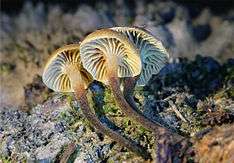Xeromphalina brunneola
| Xeromphalina brunneola | |
|---|---|
 | |
| Scientific classification | |
| Kingdom: | Fungi |
| Division: | Basidiomycota |
| Class: | Agaricomycetes |
| Order: | Agaricales |
| Family: | Mycenaceae |
| Genus: | Xeromphalina |
| Species: | X. brunneola |
| Binomial name | |
| Xeromphalina brunneola O.K.Mill. (1968) | |
Xeromphalina brunneola is a species of agaric fungus in the family Mycenaceae. Found in the western United States where it grows in dense clusters on debarked conifer logs, it was described by mycologist Orson K. Miller in 1968. The type collection was made by Miller near Priest River, Idaho, in September 1964. The mushroom has a dull orange, convex to nearly flattened cap measuring 0.6–15 mm (0.02–0.59 in) in diameter. The orange-buff gills are narrow, closely spaced, and decurrently attached to the stipe. Spores are elliptical, smooth, amyloid, and measure 5.5–6.6 by 2.5–3.0 µm.[1]
References
- ↑ Miller OK. (1968). "A revision of the genus Xeromphalina". Mycologia. 60 (1): 156–88 (see p. 167). doi:10.2307/3757321.
External links
This article is issued from Wikipedia - version of the 11/21/2016. The text is available under the Creative Commons Attribution/Share Alike but additional terms may apply for the media files.